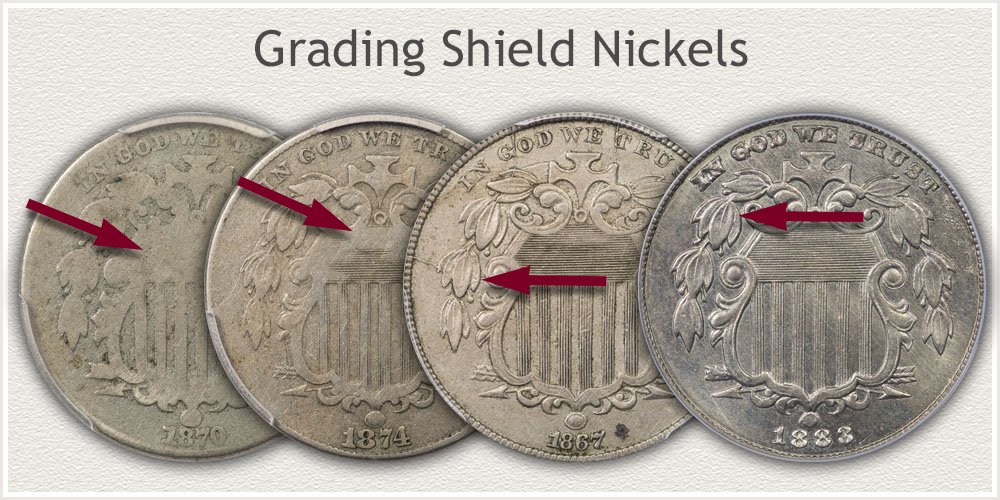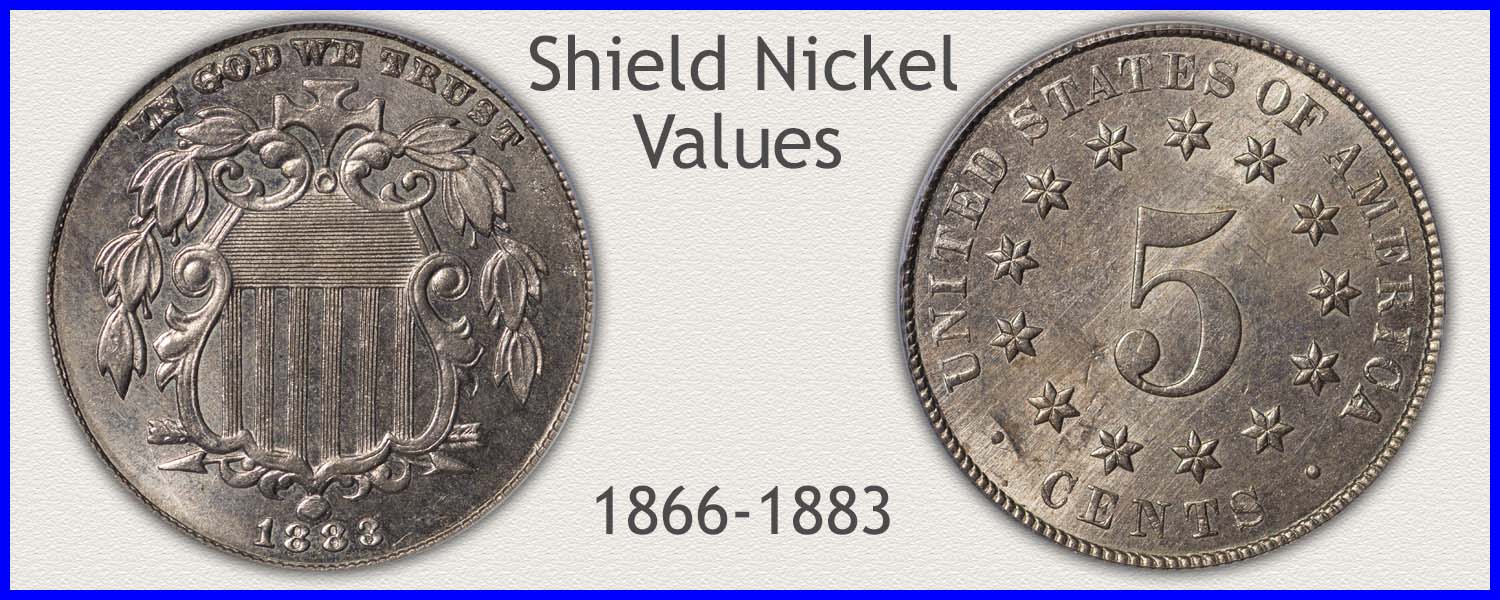Coin Values Moving with Precious Metals: Up-Dated 12/8/2025: Gold $4212 | Silver $58.12
Visual Grading Metrics
Shield Nickel Good Grade
A heavily worn coin best describes a Shield nickel in the Good grade. Flattened areas due to wear cover a large part of the surface. This amount of wear smooths most design features.
 (fig. 1G) Verify a Close Match to the Good Condition Shield Nickel
(fig. 1G) Verify a Close Match to the Good Condition Shield Nickel
Refer to your coin and the above image (fig. 1G) and determine a close match among the examples. Note the remaining detail compared to all. A Shield nickel in Good condition typically has a weak rim and few horizontal lines within the shield. Leaves are indistinct, and the coin displays a somewhat faded look. This initial inspection places your coin within a close grade range. A continued and further inspection of visual grading metrics of a Shield Nickel in good grade then refines the condition into a market accepted grade.
Visual Grading Metrics Identify Shield Nickels in Good Grade
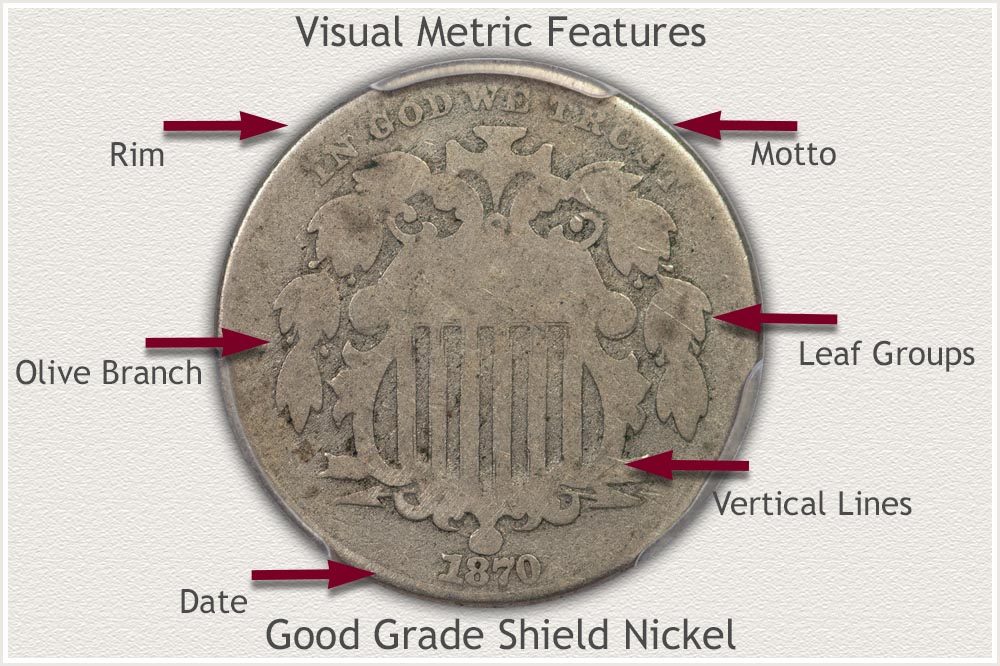 (fig. 2G) Visible Features Used to Determine a Good Grade Shield Nickel
(fig. 2G) Visible Features Used to Determine a Good Grade Shield Nickel
A Good condition Shield nickel displays typical wear patterns. These are then used when judging its grade. As a coin wears, different grades display the results of wear in unique forms on its design. Depending on the amount of wear, various levels of design flatten, and each shows typical smooth areas. Additionally, design features merge in specific areas, providing visible markers. When evaluating a coin, visible features from the outer rim to central devices are first identified. The process then inspects and measures quality. These provide the necessary metrics when grading coins.
Visual Grading Metrics: Using specific metrics, areas of the design are inspected and rated. These ratings develop into a score indicating the coin's condition. As example; six areas on a Good condition Shield nickel are rated for visibility. Their combined score, when meeting standards, decides the grade range.
Main focal points inspected when examining Good condition Shield nickels. Summary of Visual Grading Metric Locations:
- Rim: Visible Inner Edge Amount
- Date Visibility
- Olive Branches Outer Edge Visibility
- Motto: Visible Letters of In God We Trust
- Shield Vertical Lines Within Strips
- Top Leaf of 8 Leaf Groups
Research Data Provided by 20 Study Coins
Twenty professionally graded Shield nickels were examined as part of a study group. These provided a gauge to the visual qualities of a Good Grade nickel. Examining the study nickels, their specific metrics were rated and then scored. This developed insight into qualities needed to meet the Good grade. High percentages of nickels within a score show the condition of a Good grade.
🔎Tools Helping Inspect Quality of Heavily Worn Shield Nickels When inspecting old coins, always handle them by their edges. Holding the edges avoids touching the surface and allows a clear view. Viewing requires good lighting that helps bring up details. A single light source close by casts strong directional light. Contrast and shadows from the light often highlight smaller details. Using a small magnifying glass while tilting the coin is another useful tool.
The Rim and Visible Metrics
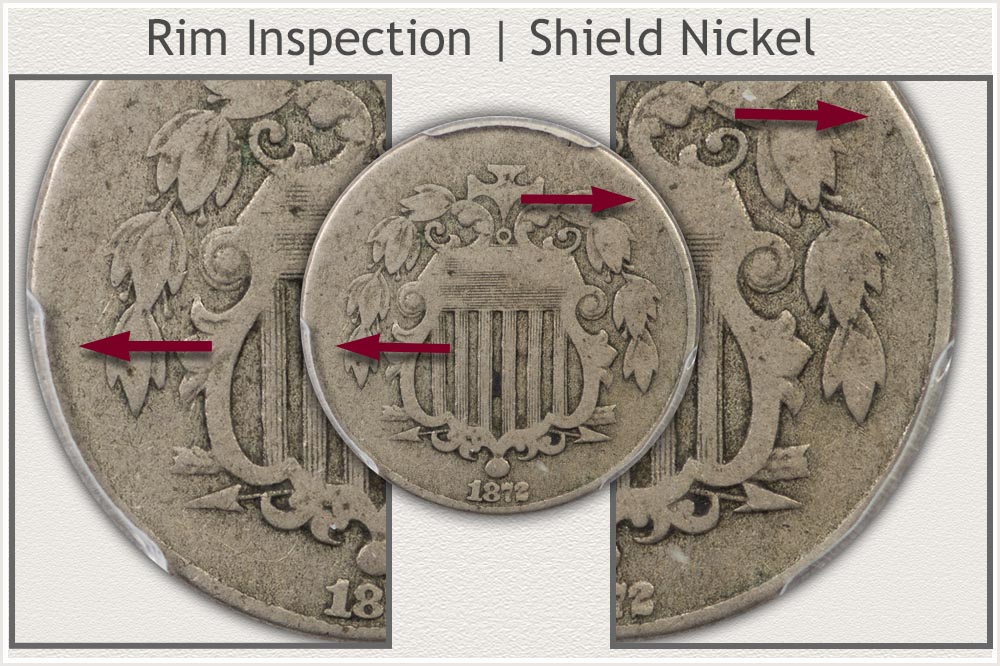 (fig. 3G) Visible Features of the Rim Used to Determine a Good Grade Shield Nickel
(fig. 3G) Visible Features of the Rim Used to Determine a Good Grade Shield Nickel
Located at the edge of the coin, the rim is a raised area around the entire design. At this stage of wear, only the rim's inner edge remains visible. A visible line along the inner edge of the rim denotes the remainder of this feature. Examine the rim area (fig. 3G) and note how far along the perimeter this line remains visible.
In the example (fig. 3G) a clear inner edge begins at the two o'clock area, continuing to a point where it fades at nine o'clock. At this point the defined line disappears and the rim now merges with the field of the coin. Measure and rate this inner edge wear pattern using these guidelines:
Visual Rating Definitions | Rim Inner Edge Detail Full: Visible line continuous along the entire rim Half: Visible line at least half or more of the rim Partial: Visible line less than half the perimeter None: No visible lines represent the inner edge of the rim
Examine the rim of the coin and determine its rating.
Rating: Rim Inner Edge Detail
|
Full |
Half |
Partial |
None |
Check the Positive Score button when Half or More of the Inner Rim Edge remains visible.
Using the ratings metrics develops a clear indication of wear amounts on the surface of a Shield nickel. Scoring these ratings helps determine grade level condition.
Scoring: Rim Inner Edge Detail
|
|
Positive Score |
Positive Metric: Half or More Rim
Research Data Results: Rim Visual Metrics
Study Group of 20 Good Grade Shield Nickels
Rating and Scoring the study nickels in Good grade produced the following percentage results.
15% | Displayed a Full Rim
80% | Half or More Rim
5% | Partial Rim
0% | Were Without a Rim Edge
Conclusion/Key Points: All the example nickels in Good grade remained with at least a partial rim. 95% showed half or more inner edge detail. However, a partial or more rim keeps the coin in consideration of the Good grade. A half or more visible rim rating becomes a strict requirement to meet the grade standard.
Aesthetics: A Half or more inner rim strongly helps a Shield nickel's quality.
Date Visibility Metrics
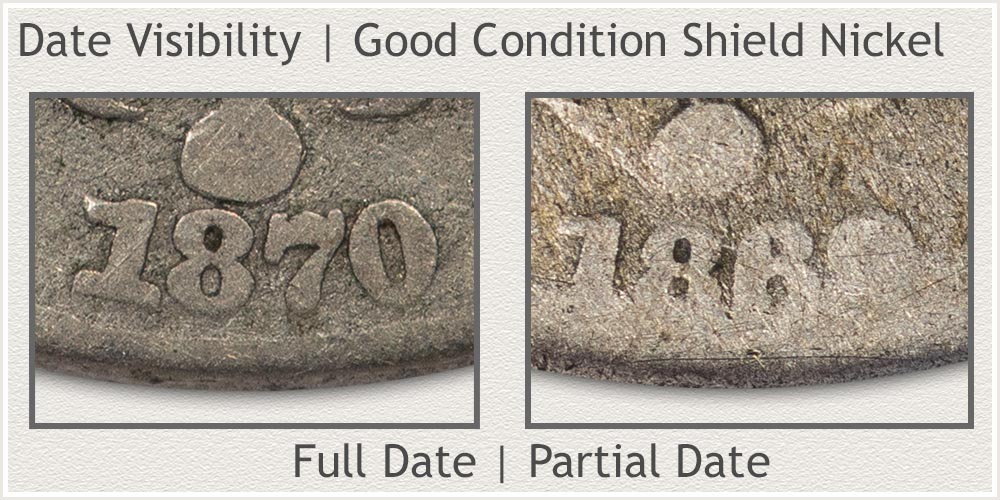 (fig. 4G) Visible Features of the Date Used to Determine a Good Grade Shield Nickel
(fig. 4G) Visible Features of the Date Used to Determine a Good Grade Shield Nickel
A legible date remaining on a Shield nickel is an important consideration. As a collectible, a strong requirement is a readable date. Many collections of coins focus on completing sets of each date of the series. A coin without a legible date falls below the collectible status.
As a grading metric, a clear and full date becomes a key point of the coin's condition. Two categories define visibility of the date. When referencing the above image (fig. 4G) either the date is Full or Partial. A Full Date remains completely raised above the field, and each digit complete. The Partial Date category indicates some of the letters are faded. Reducing their clarity, a partial date merges with the rim. Also, partial dates have faint digits slightly blended, appearing weak. As example; in the image, the "8" is missing inner definition.
Visual Rating Definitions | Date
Full: Date clear and raised above the field.
Partial: A faded but readable date, with parts blending with the rim or field.
Missing Digits: Date not clear, some digits unreadable.
Examine the date and give a rating based on its clarity and the above definitions.
Rating: Date and its Visibility
|
Full |
Partial |
Missing Digits |
The visibility of the date on these Shield nickels has a large impact on grade. To meet the Good grade: check the Positive Score button when a Full Date remains visible.
Scoring: Date and its Visibility
|
|
Positive Score |
Full Date Rates a Positive Score
Research Data Results: Date Visibility
Study Group of 20 Good Grade Shield Nickels
These ratings, Full, Partial, or Missing Digits were applied to the study group of nickels with the following results.
95% | Remained with a Full Distinct Date
5% | Showed a Partial Date
0% | None of the nickels were missing any digits
Conclusion/Key Points: A visible date, without fading into the rim, is a strong metric required to meet the Good grade standard. Of the 20 examples professionally graded as Good grade only one had a faded date. Adopting a conservative approach, consider a full date as a qualification. This gives the maximum chance to reach the Good grade level.
Of special consideration, if the date is slightly faded or merged, continue rating the additional metrics. If the coin shows strong results, a Good grade is possible.
Olive Branch Leaf Cluster Edge Visibility
 (fig. 5G) Visible Features of the Outer Leaf Edge Used to Judge a Good Grade Shield Nickel
(fig. 5G) Visible Features of the Outer Leaf Edge Used to Judge a Good Grade Shield Nickel
Beginning at the top of the shield, two olive branches extend down either side. Looking closely, these branches show four leaf clusters per each branch. To help identify the clusters, find the rows of leaf points of each group. To meet the Good grade status requires all outer edges of the leaf clusters remain complete. This is a very significant grading metric. The example image (fig. 5G) points to areas of specific interest, those prone to fading into the field.
Compare the edges of the leaf clusters in the above image (fig. 5G). All edges separate and defined from the field become the metric standard in the "Full Edges" example. On the "Faded Edges" leaves, some edges show blending into the field, mostly along outer edges.
Visual Rating Definitions | Outline of Leaf Clusters Meeting the Field Full Edges: All edges forming the outline of leaf clusters are complete. Faded Edges: Areas of the leaf cluster edges merge with the field.
Although many features of the leaves are merged and faded, the complete outline of the clusters is an important grading metric. Examine and rate the condition of the outline of all 8 leaf clusters.
Rating: Leaf Cluster Outlines
|
Full Edges |
Faded Edges |
Scoring the visibility of leaf cluster outer edges focuses on a subtle quality. Preserved edges on the perimeter of each leaf grouping place the condition within the Good grade range. Complete Full Edges Scores Positive.
Scoring: Leaf Cluster Outlines
|
|
Positive Score |
All Clusters with Full Edges Scores Positive
Research Data Results: Leaf Cluster Outline
Study Group of 20 Good Grade Shield Nickels
Rating and scoring the study group determined these percentage results.
100% | Showed Full Visible Edges Outlining Leaf Clusters
0% | Displayed Faded Edges of the Leaf Cluster Outline
Conclusion/Key Points: "Full Edges" scored 100% on the coins in the Good grade. With this result, completely outlined leaf groups becomes a solid grading metric for a coin to qualify in the Good grade. Use this visible feature as a minimum requirement to place your coin firmly within meeting a strict grading standard. A Shield nickel with any faded edges on either the inside or outside of the leaf cluster edges falls short of the grade level.
Motto: Visibility Metrics of IN GOD WE TRUST
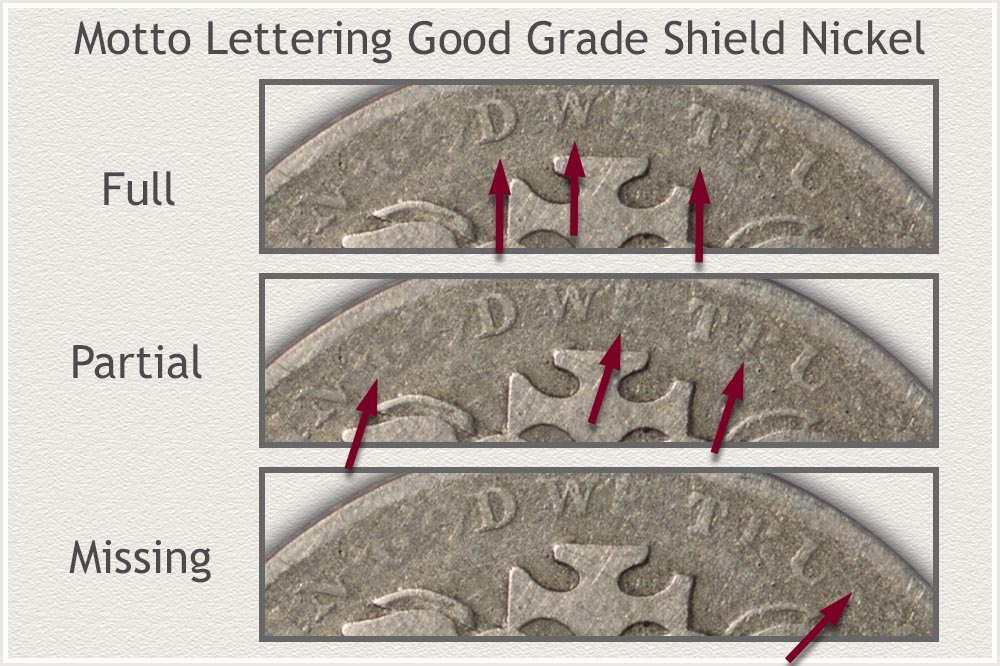 (fig. 6G) Wear Patterns on Letters of the Motto
(fig. 6G) Wear Patterns on Letters of the Motto
Placed just inside the upper rim, the motto, IN GOD WE TRUST provides a set of grading metrics according to its visibility. As wear progresses, it lowers the height of the lettering, leaving a measurable effect. Continued wear results in fading of the letters to eventually blending letters into the field. Defining a letter as Full, Partial, or Missing, places their condition into a category/rating.
Coins within the Good grade study group showed a wide range of letter visibility. These coins displayed many combinations of Full, Partial, or Missing letters. Measuring the visibility of the Motto begins to identify the grade level standard.
Refer to the image (fig. 6G) illustrating how to judge full, partial, or missing letters within the motto. Rate the visibility of each letter of the Motto by the following metrics.
Visual Rating Definitions | Letters of the Motto
Full Letter: This letter is recognizable with all visible edges.
Partial Letter: Some of the letter, usually the top, blends into the field or rim.
Missing Letter: The letter is not visible or unclear.
Rate and count the number of letters meeting the Full and Partial metric.
Rating: The Motto
Full and Partial Letter Count
|
1 to 3 |
4 to 7 |
8 to 12 |
Rating the Motto into three main categories separates the low to mid-range condition coins. Award a Positive Score to the Rating of 8 to 12 Full and Partial Letters. This identifies a Good grade category nickel.
Scoring: Letters of the Motto
|
|
Positive Score |
8 or More Full and Partial Letters
Research Data Results: Visibility of Letters Within the Motto
Study Group of 20 Good Grade Shield Nickels
Using a rating and scoring system of counting visible and partial letters results in the following percentage categories. High rated scores help place a coin solid within the standards of the grade. Compiling the results of the study nickels show the following distinct categories.
90% | Remained with 8 or more Full and Partial Letters Visible.
10% | Displayed 7 or fewer Full or Partial letters Visible.
Conclusion/Key Points: Within the study group of 20 coins, the combination of Full, Partial, and Missing letters within the Motto varied from coin to coin. However, a strong percentage difference did present at the Eight or more Full and Partial letters visible rating. With 90% of the Good grade coins meeting this metric, it becomes a significant grading factor.
One caution, a low Motto score does not exclude the coin from reaching the Good grade. It is the Motto scoring in combination with other metrics helping decide the grade level.
Visibility of Shield's Vertical Lines
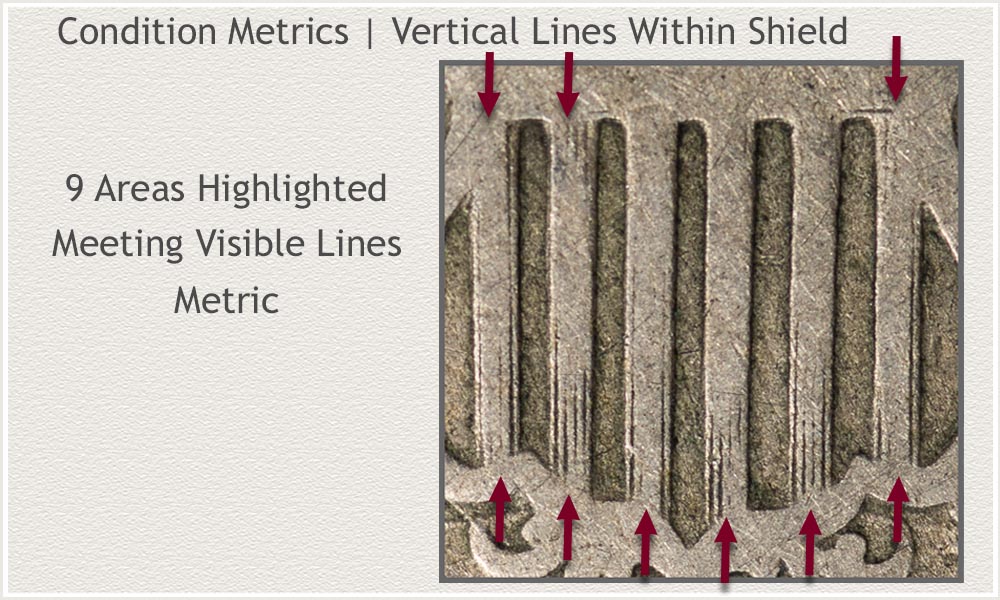 (fig. 7G) Inspecting the Vertical Line Quality of a Good Grade Shield Nickel
(fig. 7G) Inspecting the Vertical Line Quality of a Good Grade Shield Nickel
In the center of the coin are vertical stripes within the lower part of the shield device. A representation of the Great Seal. Six of these stripes are raised bars, indicating the red stripes. The lower areas either side represent the seven "white" stripes of the seal.
Useful to judge wear, the six raised bars feature fine lines separated by recesses. These fine lines fade when worn, becoming smooth. At this condition level, typically, the mid-point of the bars is smooth. Any remaining fine lines are either at the top or bottom end of the bar.
When examining the above image (fig. 7G) notice there are fine lines visible at the top and bottom ends of some bars. The top and bottom areas of the bars are the focal points of this examination. This provides a total of 12 areas used to judge their visual metric. Examine these areas applying the following ratings.
Visual Rating Definitions | Vertical Lines Within the Shield
Visible Lines: A least one fine line remains defined at the Top or Bottom of the raised bar.
Missing Lines: All fine lines are missing at the Top or Bottom ends of the raised bar.
Rate and record the number of bars with at least one distinct fine line visible along their top area. Add to this count the number of bars rating at least one fine line visible at the bottom. Note the total. In the image, along the top and bottom, 9 areas show some remaining fine lines. 9 of 12 possible areas with visible fine lines is a high metric.
Rating: Visible Lines on Vertical Stripes
|
Bars with Visible Lines at Top |
Bars with Visible Lines at Bottom |
Adding the Top and Bottom area ratings "9 or More Areas With Visible Lines" becomes the Positive Score.
Scoring: Visible Lines on Vertical Stripes
|
|
Positive Score |
9 or More Visible Line Areas
Research Data Results: Vertical Lines
Study Group of 20 Good Grade Shield Nickels
Using this visible grading metric, the results from the 20 study group nickels are below. This shows the percentage rate of nickels within the Visible Line metric.
75% | 9 to 12 Areas Displayed Fine Lines
25% | 4 to 8 Areas Displayed Fine Lines
0% | 1 to 3 Areas Displayed Fine Lines
Conclusion/Key Points: The standout metric from the above percentages shows 75% of the study nickels rated 9 or more visible areas of fine vertical lines. Coins within this top 75% group are very strong contenders to rate within the grading standard. Notable is the 25% group with 4 to 8 visible line areas. Considers these still possible to achieve the grade level once a final score is totaled.
Visibility of the Top Overlay Leaf Edge
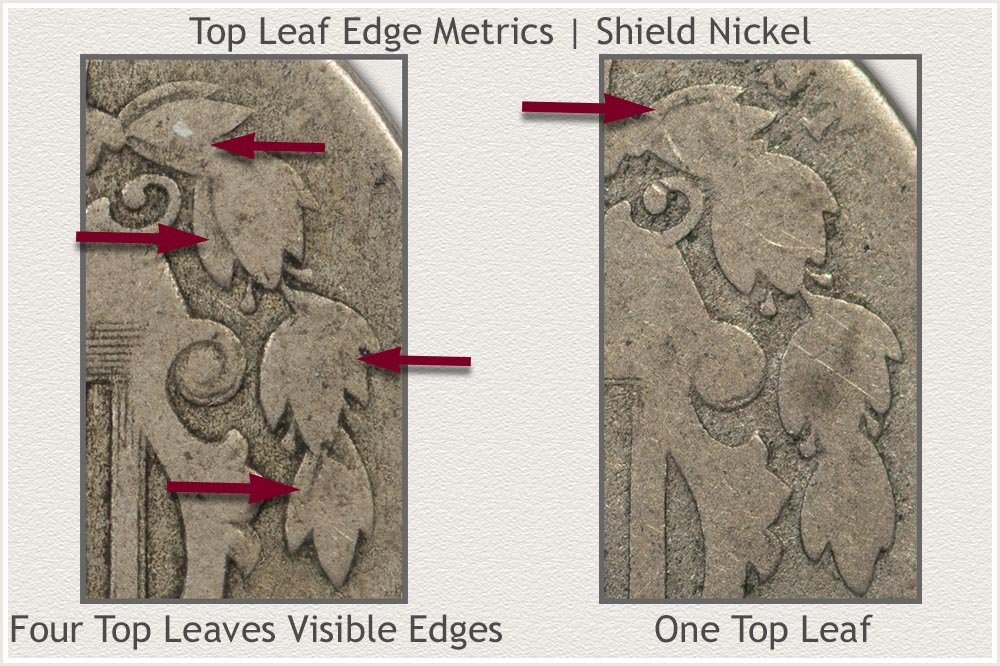 (fig. 8G) Wide Variety of Top Leaf Edge Condition on a Good Grade Shield Nickel
(fig. 8G) Wide Variety of Top Leaf Edge Condition on a Good Grade Shield Nickel
Notice the leaves on the olive branches on either side of the shield are very smooth. At this grade level, there is potential some leaf detail within the branches remains. This presents a subtle grade metric identifying the Good grade. Leaves of the two olive branches are arranged into four distinct groups per side. Starting at the top group, the original design feature is a top leaf overlaying two under. The next two clusters, a top leaf is over three leaves under. Ending with the last cluster, a top leaf overlays two below.
There are a total of eight leaf groups, each with a top overlay leaf. The Top Overleaf Edge metric examines the defining edge of these top leaves for visual quality. Reference (fig. 8G) above illustrating the finer points required to judge this metric. Looking closely at the top leaves of the left side close-up, many show one or both defining edge. The second branch, the right side close-up, shows faded, indistinct top leaf edges. Only one Top Leaf displays a defined edge.
Visual Rating Definitions | Top Overlay Leaf Edge
Visible Edge: At least one side of the top leaf has a defined edge.
Faded Edges: Nether side of the top leaf has a defined edge. The leaf blends into the lower leaves.
Applying the visual metric that requires at least one side of the top leaf is defined where it overlays a leaf below. Count and record the number of top overlay leaves meeting this grading metric.
Rating: Top Leaf Edge Visible Detail
|
1-2 | 3-4 |
5-6 | 7-8 |
Next is Scoring the results of rating the condition of Top Leaf Edges. Three or More Overlay Leaves with a Visible Edge Rates a Positive Score.
Scoring: Visibility of Top Leaf Edge Detail
|
|
Positive Score |
3 or More Top Leaves with a Visible Edge
Research Data Results: Top Overlay Leaf Edge
Study Group of 20 Good Grade Shield Nickels
The following are the percentages of nickels showing a defined edge on their Top Leaves.
10% | Displayed all 8 Top Leaves with a Visible Edge
20% | 7 Top Leaves with a Visible Edge
10% | 6 Top Leaves with a Visible Edge
15% | 5 Top Leaves with a Visible Edge
5% | 4 Top Leaves with a Visible Edge
20% | 3 Top Leaves with a Visible Edge
15% | 2 Top Leaves with a Visible Edge
5% | 1 Top Leaves with a Visible Edge
0% | No Top Leaves with a Visible Edge
Conclusion/Key Points: Despite a wide range in numbers, this Top Overlay Leaf Edge metric provides a few insights. At least one leaf remains with a visible edge on 100% of the coins examined in the Good grade condition. Additionally, among the study group, only one coin showed as few as one edge. A visible edge on three or more becomes a positive score for a Shield nickel to meet the Good grade.
Final Visual Metric Scoring | Good Grade Shield Nickel
With the results from the six visual metrics, a final score indicates the grade range of a worn Shield nickel. A strong Shield Nickel Value plus collectible status is awarded to this quality condition coin. Total the positive metrics, arriving at a final score.
A Final Score of 5 or More Positive Metrics indicates a Shield Nickel in the Good Grade range.
Final Scoring: Visual Metrics Good Grade Shield Nickel
5 or More Positive Metrics
Rates a Positive Final Score
|
Positive Score |
Design Device |
Visual Grade Metric |
|
|
Rim |
Partial or More Rim |
|
|
Date |
Full Date |
|
|
Olive Branch Outline |
Complete Outline |
|
|
Motto |
8 or More Full and Partial Letters |
|
|
Vertical Lines |
9 or More Visible Line Areas |
|
|
Top Leaf Edge |
3 or More Leaves with a Visible Edge |
Research Data Results: Final Scoring Good Grade Shield Nickel
Study Group of 20 Good Grade Shield Nickels
The Good grade nickels in the study group all scored very high. The percentage results show over half rated all 6 metrics as positive.
55% | Scored 6 Positive Metrics
30% | Scored 5 Positive Metrics
15% | Scored 4 Positive Metrics
0% | Scored 3 or Less Positive Metrics
Conclusion/Key Points: The largest percentage group, 55%, rated positive in all six metrics. Any nickel in this category has a strong position as Good Grade. With 30% of the study group scoring 5 positive metrics this coin is also considered well within the grade range. No coin scored less than 4 positive metrics. Consider these coins as possible to reach the Good grade. Review and inspect these a second time. To rate a strong for the grade condition: Use the Final Score of 5 or More indicating a Shield nickel in Good Grade.
References
U.S. Mint. Symbols on Our Coins
https://www.usmint.gov/learn/history/us-circulating-coins
Department of State The Great Seal of the United States July 2003
U.S. Mint. Catalogue of Coins of the United States
https://nnp.wustl.edu/library/book/554591
Coin Values | CoinStudy Articles
Shield Nickel | Visual Grading Metrics Series
Visual Grading Metrics: Shield Nickels Mint State Grade
Visual Grading Metrics: Shield Nickels Extremely Fine Grade
Visual Grading Metrics: Shield Nickels Fine Grade
Grading Shield Nickels | Starting Guide
Becoming familiar and recognizing the overall condition of a Shield nickel starts the grading process.
How to Grade Shield Nickels | Visual Guide
First of a new five-cent coin was introduced with the Shield Nickel in 1866. Holding the title as a "first" these nickels are popular and valued by collectors. One prominent feature of the design is the shield as a grading metric. Video and descriptions present the different stages of condition and how to grade each.
Shield Nickel Values
Next, place a value on these old Shield nickels. A step-by-step method identifies key features important when deciding how much they are worth.
Shield Nickel Value | Condition and Grade Determine Worth
A Value chart lists all dates highlighting these rare nickels. Each Shield nickel is basically scarce. Dates identify these coins. Condition and grade also determine how much they are worth. A valued coin series with collectors. Identify their date and condition and find the listing on the chart.
★Coin Values Discovery... finds Old Nickel Values and...
All old US coin values. Review the coin index with images, helping identify each series, from Cents to Gold. Value charts, grading images, and descriptions uncover how much your box of old coins is worth. Begin the step-by-step value process for each coin series.
